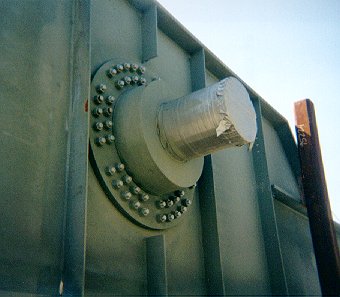DESIGN OF TRUNNION-HUB GIRDER ASSEMBLIES FOR BASCULE BRIDGES
Committed to bringing numerical methods to undergraduates

Home | Grant 1: (98-01) | Grant 2: (01-03) | Grant 3: (04-05) | Pictures | Links
|
DESIGN OF TRUNNION-HUB GIRDER ASSEMBLIES FOR BASCULE BRIDGES Committed to bringing numerical methods to undergraduates |
|
|
|
|
||
|
Home | Grant 1: (98-01) | Grant 2: (01-03) | Grant 3: (04-05) | Pictures | Links |
||
|
Numerical Models based on finite element modeling of trunnion-hub-girder assemblies of bascule bridges (Grant 1)
This study for the grant was conducted to find both the transient and steady state stresses developed during the assembly process. This study employed the method of finite element analysis to determine these stresses. ANSYS was used for the finite element analysis. The finite element approach was most suitable because it could handle the interplay of complex geometries, coupled thermal and structural fields, and temperature dependent properties. This study used critical crack length and hoop stress, for comparing the two assembly procedures. Using a parametric model, transient stresses in the two alternative assembly procedures for different bridges were compared with the aid of time-history plots of temperature and stress. This study hypothesized that in AP1, a combination of high hoop stress and low temperature result in smaller values of critical crack length, possibly leading to crack development and growth. In AP2, stresses due to interference never occur together with the thermal stresses during the cooling process, resulting in larger values of critical crack length, thereby reducing the probability of crack development and growth. It concluded that the results of the finite element analysis broadly agreed with the hypothesis. It also stated that every bridge was different and needed to be analyzed separately. REPORTS Full report (Acrobat Format ; Word Format) |
| Mechanical Engineering| University of South Florida | FDOT | Contact us |
 |